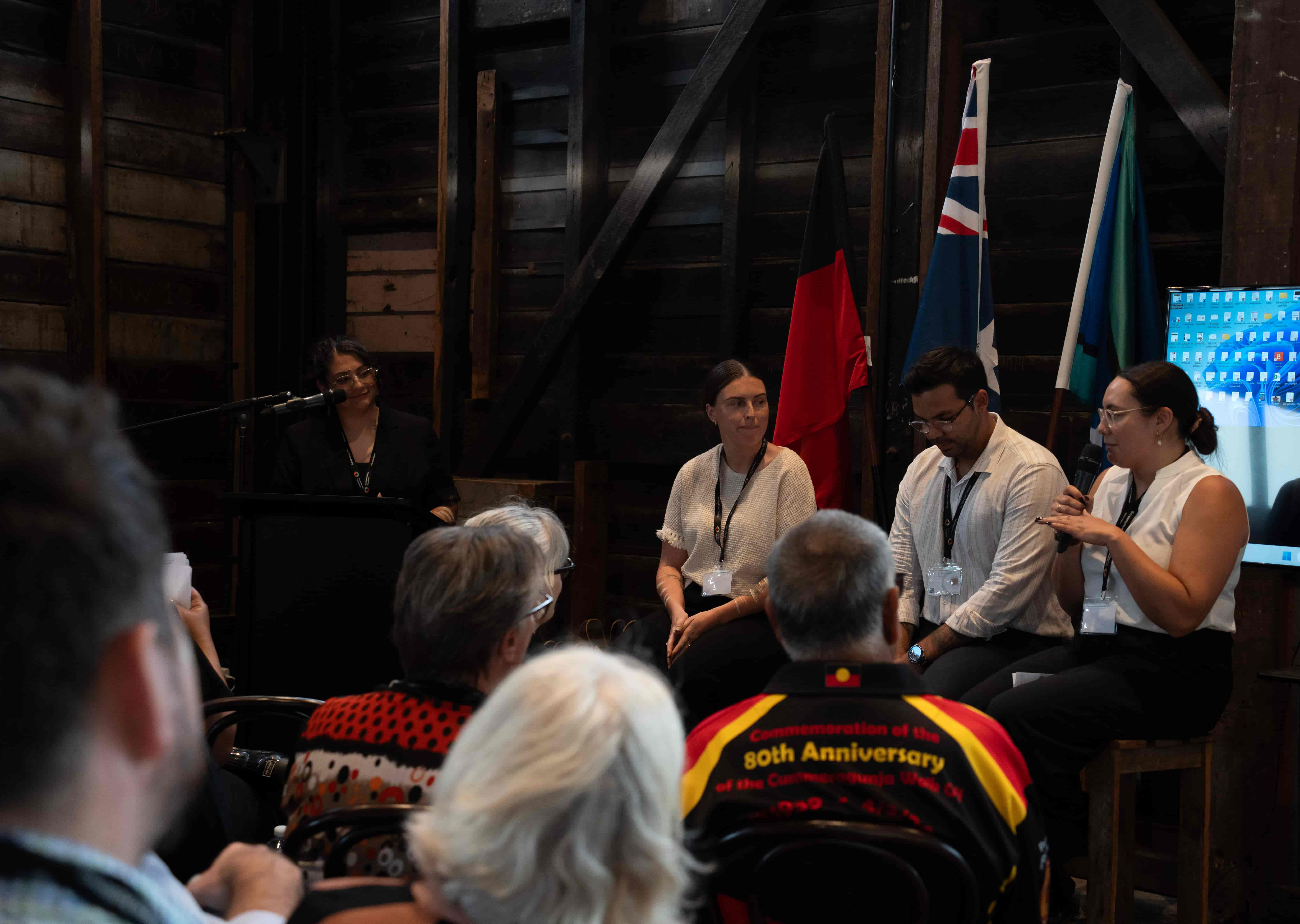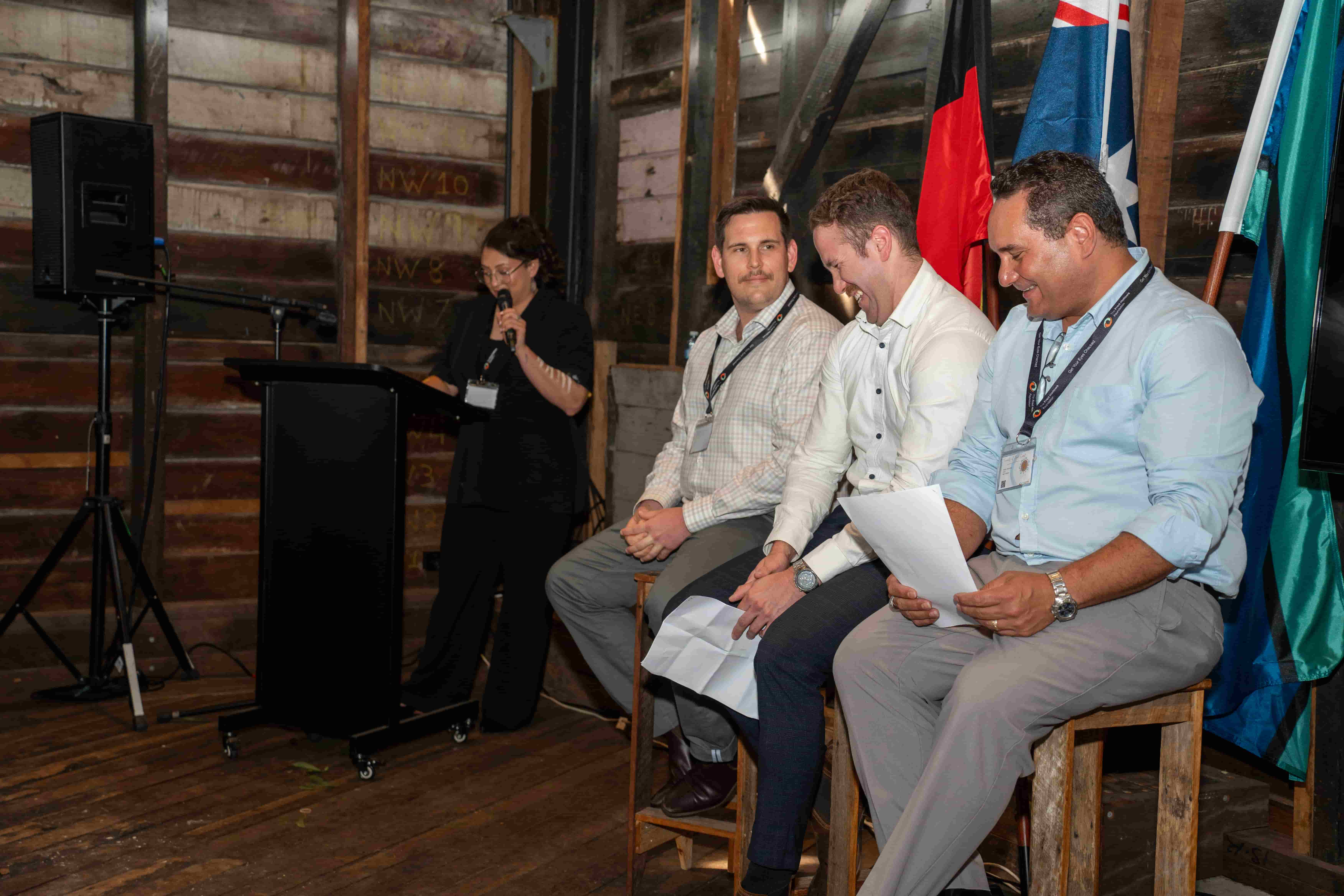Friends of Fred: A day of connection, culture, and advocacy in eye health

On Wednesday 22 October at Bangarra Dance Theatre in Sydney, the first ever ‘Friends of Fred’ event brought together the Aboriginal and Torres Strait Islander eye health sector in a powerful show of unity, advocacy, and collaboration.
The event was attended by Aboriginal Community Controlled Health Organisations, national peak body representatives, non-Indigenous sector stakeholders and corporate partners such as Specsavers and Blackwoods, and MC-ed by the Foundation’s own Madison Cassady. The day was interspersed by cultural performances from a small group of Aboriginal and Torres Strait Islander students from St Mary- St Joseph school in Maroubra (before they were joined by the rest of their cohort to perform a rendition of 'I Am Australian' - the first verse in language and the following in a combination of English and AUSLAN) and the Mui Mui Bumer Gedlam dance group winners from the Torres Strait Islands.
 Photo credit: Natasha Williams
Photo credit: Natasha Williams
Attendees travelled from all over the country - including Tennant Creek (Warumungu Country), Bunbury (Kaniyang Country), Darwin (Larrakia Country), Townsville (Bindal Country), Melbourne (Wurundjeri Country) and more, creating a space that felt unifying and meaningful, in particular rural and remote eye health workers who frequently mention the isolation inherent to their jobs.
We started our day with a beautiful Welcome to Country from proud Dharawal and Dhurga man Uncle Lloyd to the Gadigal land upon which our event would take place, as well as a smoking ceremony led by proud Dharawal man David Johnson.
 Photo credit: Natasha Williams
Photo credit: Natasha Williams
Indigenous Australia Program (IAP) Country Director, Tanya Morris opened the inaugural event by reaffirming the Foundation’s position as a steadfast ally in the Aboriginal and Torres Strait Islander eye sector.
Given that we structured the day to move from past, to present, to future, it seemed only fitting that Gabi Hollows AO was the first speaker to take to the lectern, followed by Uncle Reg Murray. Gabi and Uncle Reg spoke of their time on the National Trachoma Program in the 70s with Professor Fred, Uncle Trevor Buzzacott, Uncle Reg’s then-wife Rose Murray, Jilpia Jones and Gordon Briscoe, as well as Patricia O’Shaugnessy, who tragically died whilst they were on the road.
Gabi and Uncle Reg painted a vivid picture of the National Trachoma Project, not just speaking to the impact the project had on Aboriginal and Torres Strait Islander eye health but also to how much fun everyone had together. It was such a seminal chapter in their lives that Fred and Gabi’s wedding cake was actually a map of all the communities the Project visited.

 Photo credit: Natasha Williams
Photo credit: Natasha Williams
Taking us seamlessly from past to present was the longest standing member of the Indigenous Australia Program (IAP) team and current Programs Manager Tania McLeod. Tania recounted the winding history of IAP, which changed shape and focus at various points on human rights, the social determinants of health, nutrition before arriving to our present-day focus: eye health and self-determination. Tania shared her favourite quote of Professor Fred’s, that “the basic attribute of mankind is to look after each other”, adding that if you truly believe that - then you’re in the right room.
 Photo credit: Natasha Williams
Photo credit: Natasha Williams
Lose Fonua, CEO of the First Nations Eye Health Alliance, took over from there, speaking to the integral role of the Alliance, as the self-determined peak body for Aboriginal and Torres Strait Islander eye health, in driving progress in the sector. She spoke to the current priorities for the Alliance as well as what they’ve managed to achieve to date with limited resourcing, before sharing a personal story about her son who was misdiagnosed with behavioural issues when, really, he just couldn’t see the board. With new glasses he’s on track to catch up with his classmates before the end of the year.
 Photo credit: Natasha Williams
Photo credit: Natasha Williams
Following Lose was another example of what a self-determined vision for eye health looks like – Shaun Tatipata, Director of the Deadly Vision Centre, Australia’s first Aboriginal-owned and operated vision centre on Larrakia Country in Darwin. Shaun shared how his approach, which emphasises the importance of clinical and cultural care, is resonating strongly with the community. Shaun’s presentation, which also touched on his dedication to training the next generation of Aboriginal and Torres Strait Islander eye health professionals, made it emphatically clear why investment in locally-led solutions is the only way forward.
 Photo credit: Natasha Williams
Photo credit: Natasha Williams
Our first panel discussion straddled present and future perfectly, with panellists Tori Towney (Rural Doctors Network), Sarah Haynes (South West Aboriginal Medical Service) and Dr T’Kido Titasey (Queensland Health) sharing their views on what strong partnerships look like – between universities and students, jurisdictional fundholders and fund recipients, doctors and patients, visiting service providers and local medical services. The key takeaways? Every community is different – taking time to listen and learn from, and be led by, leaders and community members is key to the delivery of culturally responsive eye health care. In discussing the importance of universities not being exempt from the directive to listen and learn, Sarah shared that she will commence her study to become an optometrist in 2026 following working with the University of Western Australia to develop an Indigenous entry pathway that didn’t previously exist.
Our second panel discussion kept us firmly focused on what needs to come next, rallying us as the day came to a close. Karl Briscoe (National Association of Aboriginal and Torres Strait Islander Health Workers and Practitioners), Jed Fraser (Indigenous Allied Health Australia) and Dr Thomas Mylne (FNEHA, Ophthalmology Registrar) shared their government and policy expertise, directing attendees to pieces of policy that they believe everyone should be aware of: the National Agreement on Closing The Gap, the National Aboriginal and Torres Strait Islander Health Workforce Strategic Framework and Implementation Plan and the National Aboriginal and Torres Strait Islander Health Plan, as well as the new Australian Health Practitioner Regulation Agency cultural safety legislation and the United Nations Declaration on the Rights of Indigenous Peoples (UNDRIP).
Challenged to leave the audience with a key takeaway in under 30 words or less, Briscoe urged the room to listen to Aboriginal and Torres Strait Islander voices and leadership, Fraser reminded us that investing in the Aboriginal and Torres Strait Islander workforce will benefit all Australians, and Myle encouraged us to challenge the narrative, disrupt the system, and be brave.
 Photo credit: Natasha Williams
Photo credit: Natasha Williams
Closing out the day was the inimitable Jaki Adams, former Director of Social Justice and Regional Engagement at the Foundation and current Executive Manager of Research and Knowledge Translation at the Lowitja Institute. Jaki closed the day by reminding us that there is no equity in eye health without social justice – meaning that social justice is everyone’s business. She spoke to the Uluru Statement from the Heart as a document that remains as relevant as ever, regardless of the result of the 2023 Voice Referendum. She encouraged self-reflection in allies – asking them whether they were able to get out of their own way and make space for Aboriginal and Torres Strait Islander people to lead – and reminded everyone of the power in the room: “we survived, we’re resilient, we’re still here, we’re not going away.”

 Photo credit: Natasha Williams
Photo credit: Natasha Williams
